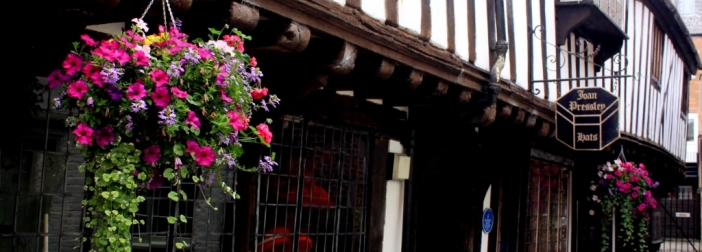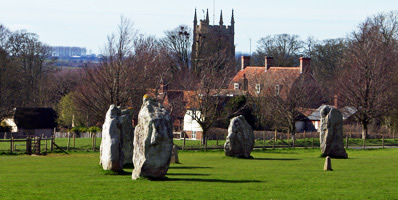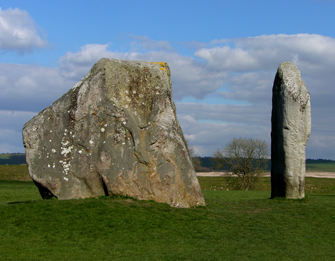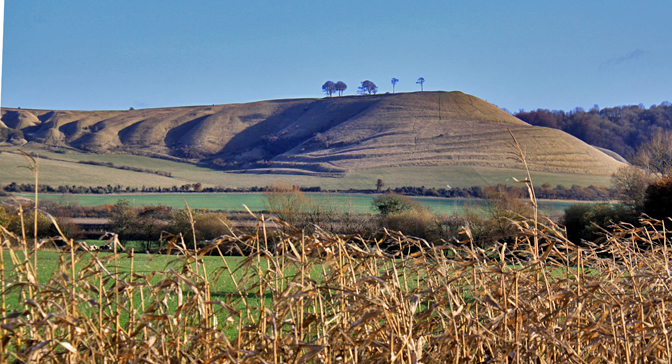Prehistory, History and Archaeology of the Devizes Area of Wiltshire
News: Digital Mapping has provided a useful online archaeology resource which has a lot of interesting information including maps and photos of local sites. Just two are picked out below to give a flavour of the site.
Background to our prehistory in Wiltshire and England.
The Ancient Human Occupation of Britain (AHOB) study has shown that ancestors of modern humans came to Britain and were forced to leave (or died) eight times. Dr. Chris Stringer of the Natural History Museum has led a multi-university team; they have found that the first occupation of Britain was at least 700,000 years ago in Pakefield, Suffolk. They were ancestors of the Neanderthals and used crude stone tools. On seven occasions ancient man failed to maintain a foothold in Britain - they were beaten back by freezing conditions. This has arisen because of cyclical ice ages and warmer periods. An AHOB map / diagram of the peopling of Britain and Europe illustrates the cyclical ice ages and archaeological sites in three eras over the last 1 million years. It is well worth studying.
Stephen Oppenheimer, in conjuction with the Bradshaw foundation, has developed an illustrated slideshow with many maps showing how modern humans migrated out of Africa 70,000 years ago, reached Australia by at least 50,000 years ago and Europe by 40,000 years ago.
Palaeolithic Age in UK and Wiltshire - ca 13,00 BC to 10,000 BC
Modern humans were present in Britain before the last ice-age; human bones ca 28,000 years old have been found for example in Paviland cave in the Gower. But from ca 20,000 BC to 12,000 BC Britain was unoccupied by any human species it was an ice covered desert. 12,000 years ago Britain was connected to the European continent and England, Wales and Scotland were connected to Ireland. So about 12 to 15,000 years ago modern humans left their ice-age refuges in northern Spain and southern France and travelled up the coast of Europe, walking to Ireland, Wales and the west country of England along the coast.
New information from Y and Mitochondrial gene DNA analysis is indicates how ancient immigration came about. Stephen Oppenheimer in his 2007 book "Origins of the British" has synthesised gene studies, archaeology, geology and language analysis into a new picture. He shows how two thirds of the English people reveal an unbroken genetic line to south-western Europeans from their ice age refuges. They arrived in Britain long before the farmers 12 to 14,000 years ago. Most of the remaining one third arrived between 6000 and 300 years ago as part of long term north-west European trade and immigration across the North Sea and especially from Scandinavia - possibly carrying the earliest forms of English.
Mesolithic Age in Wiltshire ca 10,000 BC to 4,000 BC
As Europe warmed,up humans advanced culturally into the Mesolithic era from about 10,000 BC onwards. This age was characterised by the use of microliths ( small flint blades) and saw the flourishing of the hunter gatherer lifestyle in Britain. Large game such as mammoths and bison were dying out and there was extensive usage of coastal marine resources. There are 19 Mesolithic sites recorded in the "Seven parishes study" around Devizes
The Neolithic Age in Wiltshire - ca 4000 BC to 2400 BC
Wiltshire has two prehistoric henges which are World Heritage sites - Avebury and Stonehenge. Avebury offers a diverse range of prehistoric sites to captivate the visitor just 9 miles from Devizes. There is an archaeological museum, National Trust shop, an interpretation centre, pubs and a community run village shop.
Below: Avebury the Neolithic stone circle & church
During the Neolithic or New Stone Age people began to take up an agriculture way of life and stopped being nomadic hunter-gatherers. Sometime around 4000 BC the ideas and technology of farming and some livestock, crossed the Channel and arrived in England. Farming gradually spread across the British Isles, promoting social change as eventful as the Industrial Revolution 6000 years later. There has been a great debate in anthropology and archaeology about whether there was an invasion of Middle Eastern farming pioneers, travelling through central Europe and the Mediterranean, who may have replaced an indigenous British population. The genetic evidence is clear; new culture (farming and pottery) were brought in by "immigrants"; this was passed on to a local existing population. Replacement of peoples did not happen; peoples mixed and learnt from each other. It is also clear that a purely agricultural life style was almost impossible at this time; it has been noted that an agricultural diet alone is not necessarily a better diet. Humans grows taller and stronger on a meat protein diet and a mixed economy of farming with local hunting emerged during the Neolithic age.
There are 63 Neolithic archaeological sites in the 7 Parishes around Devizes - Seven Parishes SMR Study
The West Kennet Avenue leads from Avebury to the sanctuary. Although these people were farming, they had not worked out all details of crop management, so that every 10 - 20 years the land would no longer support crops and the group moved on. Each group, probably no larger than an extended family, seems to have moved around a fairly small region in this way; packing up when the land would no longer produce. In a few generations they could have returned to the original settlement after the land had lain fallow long enough to regenerate. Clothing was simple hide garments. Ornamentation was extremely simple; animal teeth and bone necklaces. Life span was short, about 35 years for men and 30 for women. Arthritis was rampant as was malnutrition. .
Silbury Hill is just one of a number of internationally important prehistoric monuments found along the valley of the River Kennet, which now form the core of the Avebury World Heritage Site. Some of these monuments, such as Windmill Hill and Avebury Henge, were gathering places. Some, such as the West Kennet long barrow, were burial places, and others such as the West Kennet stone avenue connected one place to another. These monuments were constructed and used over a very long period. The people who built the late Neolithic Silbury and Avebury were more distant in time from the original builders of the early Neolithic Windmill Hill and the West Kennet long barrow than we are from the Normans and their castles.
Silbury Hill was built in about 2400 BC at the bottom of a spur of down land running into the Kennet flood plain. This winter photo at left shows that the monument was close to water which was so important physically and spiritually to the Silbury builders. This site marks the head of the Kennet River on a year round basis. 2009 research has shown that Silbury started out as a conventional circular henge with a ditch and bank. At its centre was a low 1.5 m high raised area possibly for meetings and worship. There is a 19 m high mound in the grounds of Marlborough College. Recent research by Jim Leary of English Heritage shows that this too is prehistoric. They have obtained carbon- 14 dates to 2400 BC. It is Silbury Hills little sister and shows a more widespread culture of mound building in the Kennet valley.
These activities took place against a backdrop of a landscape that was gradually being cleared of trees and used for grazing animals and cultivating crops. But recognisable fields did not appear until much later. These monuments were not built at the same time, but they were used together as people visited the old monuments and created new ones, to interpret their past and mark their own presence in this extraordinary landscape.
The Bronze Age in Wiltshire - ca 2400 BC to 800 BC
About 2400 B.C. migrants settled in Britain who have become known as the Beaker People; because of the shape of the pottery vessels which are often found in their round barrow graves. They were farmers, used bows and had arm protection against the bow string. They were importantly metal workers who introduced this metal working culture to Britain
The Wiltshire Heritage Museum on Long Street in Devizes is home to the best Bronze Age Collection in Britain. It has outstanding collections that trace the fascinating history of Wiltshire, its environment and its people over the last 6,000 years. Their Bush Barrow finds have been described as the Crown jewels of the "King of Stonehenge".
The rich "Amesbury Archer" finds were made by Wessex Archaeology and the skeleton and some grave goods are displayed at the excellent Salisbury Museum. This illustrates that by about 2400 BC metal working, including gold and bronze, had arrived in Wiltshire. The older man was a high status metal worked and came from Europe, possibly Switzerland. His younger relative (son?) was born in England. They were the first metal smiths in Britain, working first in copper and gold, and later in the bronze which has given its name to this era.
There are 35 SMR sites recorded in the "Seven parishes study" around Devizes
The general society became more patriarchal and it is during the Bronze Age that the individual warrior-chiefs or kings gained importance. This contrasted with the community orientation of the Neolithic times. In the bronze age round barrows were often clustered in groups. This suggests that these were family cemeteries. These were sometimes close to earlier Neolithic henges and monuments, suggesting a continuity of occupation of sites that already felt to be sacred. The barrow graves were generally filled with grave goods, indicating the importance of the dead person and a belief in some kind of afterlife. Some of the goods included in barrows were: pottery jars, golden buckles, bronze daggers, cups, necklaces, and sceptres in various stones and precious materials. Both men and women were accorded barrow burials. A curious fact has been noted by some archaeologists; they noted that some Bronze Age burials the corpses were carefully laid with the head to the south, men facing east, women facing west. Possibly this was to allow the corpse to see the sun at a particular time of day. Stone circles were also a feature of the Bronze especially in Wessex. Although circles may have been erected as early as 3400 B.C., the major circle building era was during the Bronze Age.
Archaeology of Devizes - a 2004 study for the Archaeology Service of Wiltshire Council (Copyright Wiltshire Council and English Heritage). This is an excellent study with illustrations and maps showing how Devizes has evolved from prehistory through the Norman,medieval and more modern industrial times.
Archaeolgy of 7 Parishes around Devizes, by Alan Carter. This organises the Sites and Monument records for Devizes; Bishops, Cannings, Bromham, Devizes, Heddington, Roundway and Rowde parishes and categorises them into archaeological age. Four bar charts show the frequency of sites by archaeological ages and parish.
Avebury - a useful website about the history and archaeology of the Avebury area.
Buildings that have survived in Devizes since Norman times, listed by century.
Historic and Listed buildings in Devizes this contains some details and reports on Grade 1 and 2 listed buildings and is a Devizes Heritage page.
Oliver's castle history and archaeology of this Iron Age fort - should we call it Bromham fort?
Past Horizons The Past Horizons site is free to use. Please take time to read the articles, watch the videos, read and enjoy the current world news, updated on a regular basis.
Roman finds near Devizes - a Devizes Heritage study that gives Romano - British sites for Bishops, Cannings, Bromham, Devizes, Heddington, Roundway and Rowde parishes. The study includes bar graphs. The Crammer Pond is a high but natural spring filled pond. Undoubtedly romano british people settled nearby as evidenced by the finds and two known villas and a cemetery nearby
Wansdyke a 5th Century ditch and bank 72 km long from near Bristol, over Morgan's Hill near Devizes to the Savernake Forest near Marlborough.
Wiltshire Heritage Museum The Wiltshire Heritage Museum on Long Street in Devizes is home to the best Bronze Age Collection in Britain. It has outstanding collections that trace the fascinating history of Wiltshire, its environment and its people over the last 6,000 years. Their Bush Barrow finds have been described as the Crown jewels of the "King of Stonehenge".
Wiltshire Sites and Monument record (SMR), Wiltshire Council Home page
Above:Oliver's castle - an Iron Age fort and Roundway covert far right. There was Roman villa under Roundway Covert near Mother Anthony's well.
|








 There was a changeover during this period to round houses that reflected the growth of stone circles and round barrow mounds. Their huts probably had a low stone wall for a base which was used to brace wooden poles and rafters. On top of this would have been a roof of thatch, turf, or hides. They made their own pottery, and eventually the first woven garments in Britain .They also introduced the first known alcoholic drink into Britain, a form of honey-based mead. The Beaker people developed a pastoral pattern to the agricultural lifestyle of Neolithic times. As population grew, more marginal land was brought into cultivation, and was farmed successfully for hundreds of years, until climate changes forced its abandonment. Towards the end of the Bronze Age the climate changed drastically. According to tree ring evidence, a major volcanic eruption in Iceland may have caused a significant temperature drop in just one year. At this time the settlements on Dartmoor were abandoned, for example, and peat started to form in many places over what were once farms, houses and their field systems.
There was a changeover during this period to round houses that reflected the growth of stone circles and round barrow mounds. Their huts probably had a low stone wall for a base which was used to brace wooden poles and rafters. On top of this would have been a roof of thatch, turf, or hides. They made their own pottery, and eventually the first woven garments in Britain .They also introduced the first known alcoholic drink into Britain, a form of honey-based mead. The Beaker people developed a pastoral pattern to the agricultural lifestyle of Neolithic times. As population grew, more marginal land was brought into cultivation, and was farmed successfully for hundreds of years, until climate changes forced its abandonment. Towards the end of the Bronze Age the climate changed drastically. According to tree ring evidence, a major volcanic eruption in Iceland may have caused a significant temperature drop in just one year. At this time the settlements on Dartmoor were abandoned, for example, and peat started to form in many places over what were once farms, houses and their field systems. 